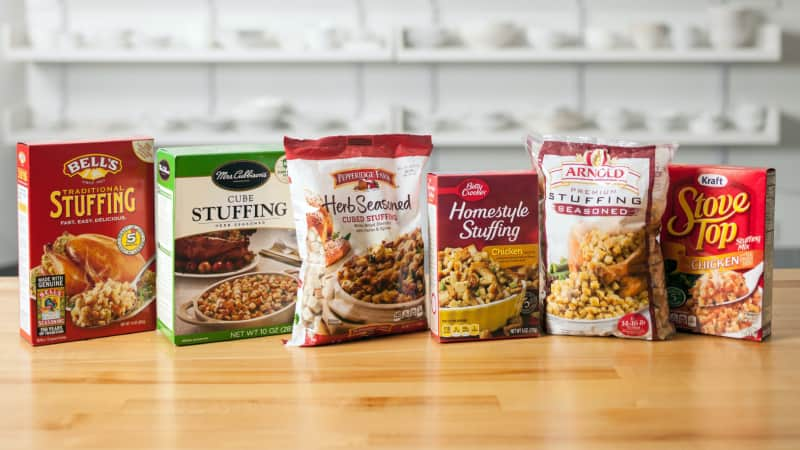The Best Supermarket Turkey
Taste Test
In just 10 minutes, you can have a side dish for a holiday roast or weeknight dinner. But will it be any good?
Published Oct. 1, 2018.

We've devoted countless hours and hundreds of pounds of bread to developing stuffing recipes. Whether we make it with a simple combination of herbs and vegetables or include extras such as dried fruit or sausage, we know how to get perfectly moist, chewy-tender bread with the ideal distribution of flavorings. Homemade stuffing isn't particularly difficult to make, yet Americans still spend $258 million on packaged versions each year. Part of the appeal is how easily and quickly the box stuffing comes together—it can be ready in 10 minutes—and the rest is nostalgia. For Thanksgiving dinner or a quick weeknight meal, which store-bought stuffing is best?
We first identified six top-selling brands and then narrowed our focus to stuffings made with white bread or a mix of white and whole wheat. Each company sells several poultry-flavored or traditional seasoned options, so we held preliminary tastings to identify our favorite from each brand. Our final lineup of six stuffings, priced from $1.65 to $4.14 per container ($0.21 to $0.41 per ounce), included two chicken-flavored stuffings and four “traditional” or “seasoned” options. We prepared each stuffing on the stove according to the package directions and asked panelists to rate them all on flavor, texture, and overall appeal.
We were surprised at how much the boxed stuffings varied—and at how much some missed the mark. A few were bland, tasting only of bread and salt. The rest were intensely seasoned. Our tasters liked both “chicken-y” and “herby” stuffings, but even the best from each category had an “artificial” quality. Tasters thought they seemed “chemically designed to taste savory,” more like a “Lipton soup packet” or “instant ramen” than real stuffing.
They also varied in texture and, more important, moisture. One product was so dry that tasters asked, “Is this plain bread cubes?” Another was very “wet” and “mushy,” and a third was “moist in some spots and dry and crouton-like in others.” Worse, some had a weirdly “gluey,” “slimy” quality. Tasters much preferred stuffings that were evenly moist. Our favorites struck a balance between wet and dry, with visible pieces of bread that clung together to form a “cohesive” texture.
After reviewing the results of our tasting, we compared the package instructions. Most required heating butter and water to a simmer, stirring in the stuffing, and letting it sit for a few minutes to rehydrate. Two lower-ranking products replaced the water with broth and called for first softening diced celery and onion in the butter. Neither addition made for bette...
The mission of America’s Test Kitchen Reviews is to find the best equipment and ingredients for the home cook through rigorous, hands-on testing.

Kate is a deputy editor for ATK Reviews. She's a culinary school graduate and former line cook and cheesemonger.

This is a members' feature.